Launch Report: September 29, 2001
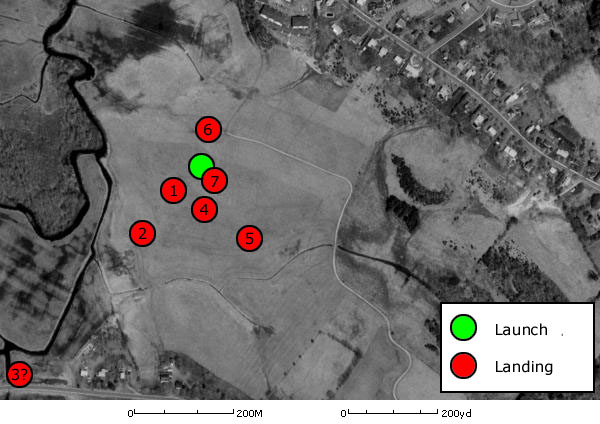
There was a lot of wind, which led to a bunch of problems. Many rockets were weathercocking badly, some to the point of being dangerously ballistic. Most people were tilting their launch rods strongly into the wind, flying their rockets way out past the cars, and still the rockets would drift back over the launch pad and well down range. 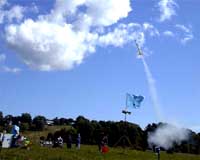
The maiden flight of the Echostar. For my first flight, I took the sustainer of the Echostar and gave it a shot on a C6-3 to make sure that it would fly OK. I didn't tilt the launch rod enough, but at ejection one of the parachute shroud lines got caught on the canards and tore. This left a tangled chute that was acting more like a big streamer, and the rocket fell relatively quickly. The grass was about 6" high on the field so landings were soft and there was no damage. I repaired the parachute damage and started prepping the rocket for a two-stage flight. This would be my first attempt at staged flight, and my first try for the staged flight requirement of NARTREK bronze. It wasn't clear to me how the sustainer motor gets ignited, so I asked for advice from someone that looked clueful. He recommended I sand down the booster coupler to make it less tight and also to punch a couple pressure releif holes in the booster so that it wouldn't fall off before the burning propellent particles could find their way into the sustainer motor. 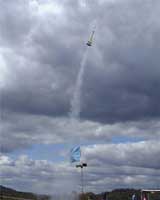
The Echostar launching with booster. Having done this, I put a C6-0 in the booster and a C6-5 in the sustainer and let her rip. The flight was a good one, with the second stage igniting very quickly. Booster separation was nominal, though I didn't watch it fall and Mikkel had to retrieve it for me. The parachute deployed normally this time. I guessed the launch angle pretty well, and had to walk about 150m to retrieve the rocket. No damage, successful NARTREK bronze two-stage flight! After watching Mikkel fly a couple of his new rockets, I decided it was time to burn my F25-6W in the Initiator. The FAA had granted us a notification for large model rockets at the last moment, freeing us from the 1.5kg GLOW restriction. This is good because the Initiator with the F25 is just over 1.5kg. 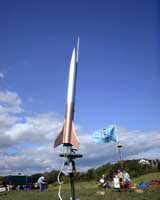
The initiator on its way to... somewhere. There was apparently a short in my copperhead ignitor, because it wouldn't launch on the first two tries. I traded my ignitor with Pete Chestna for another one and reprepped. This time the LCO had to wait on the launch because the wind was really gusting and the rockets were getting swung around on the launchpads. When the wind died down some and he hit the button, the engine chuffed for awhile before taking of with an enormous roar and great flame. The flight looked great, deploy was nominal, and it was way up there. I definitely had not angled the launch rod enough; I was in for a long walk. There are some barbed wire fences and little swampy streams inbetween the launch pad and where the Initiator was heading, so it took me awhile to get down range. As I was heading that way, I saw the rocket have a close encounter with the high-tension power lines near the road, floating just over them. Then my line of sight to the rocket was interrupted by a nearby tree and I had to interpolate where the rocket had landed. Mikkel, who was also in this area retrieving his Estes Star Dart, helped me search for the Initiator. We did a wide search through the low-cut hay fields, along the road, along the swamp, etc. We spent about 45 minutes looking for the rocket to no avail. It is lost. In retrospect, looking at the satellite image of the area and the path I took to get around one of the barbed wire fences in relation to where I saw the rocket floating last, I think we didn't look far enough west along the road. My guess is that it went over the road and just west of the edge of the image above. This is a region we didn't search and there are some trees. Maybe I'll hike over there at the next launch and see if I can find it, but it's likely that the rocket is gone. My most expensive and largest rocket, AWOL. 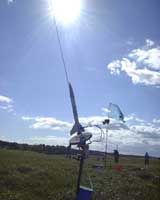
The indestructable Astra I. Being somewhat annoyed at the loss of my best rocket, I thought maybe I should try to lose my Quest Astra I, which I have harbored malicious intent towards since I got it. I put a C6-5 in it and let it go. But, predictably, the wind died down and the rocket came down a short walk from the launch pad. Perfect flight. Maybe I should just buy rockets I don't like, as they seem to work better. My other goal of the day was to finish up my NARTREK bronze with a 30-second streamer duration flight with the Pip Squeak. I was hoping to put the streamer from Mikkel's Viking in it in addition to the original streamer. However, Mikkel had just flown the Viking and lost it. I helped him search for it for some time and failed. So I prepped it with a B6-4 and launched it with the factory streamer to see how it faired. 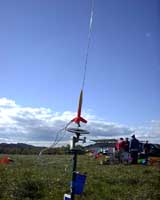
Not capable of 30 second duration flights. With the weathercocking the rocket flew much more horizontal than it normally does and didn't get as high, so the drift time was predictably shorter. Flight duration came in at 22.4 seconds. I traded a C6-3 to some guy for a B6-6 and loaded that up. At which point Mikkel found his Viking and donated the streamer to the cause. He had managed a 31 second flight on his first try; beginner's luck. The two streamers were difficult to fit inside the squat body tube of the Pip Squeak. I had to really crush the nose cone down. The flight was somewhat eratic, with heavy coning, probably a misaligned nosecone. The deploy was far too late with the six-second delay and Mikkel's streamer didn't unfurl and just added weight. The rocket fell to the ground in 17.0 seconds. 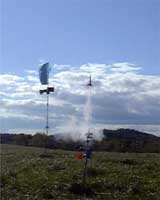
Soon to be on the grass. Very soon. It was getting late, but I wanted one more try at this. I went back to using the B6-4's (my last one), and talked to John Buscaglia about my streamer woes. He had a bunch of competition streamers but they were all far too large for the body tube. He gave me a package of 2" paper party streamer with which I fashioned a big wide streamer for the rocket. This time, the rocket went crazy unstable on launch and powered into the ground near the launch site, similar to the random unstable behavior at the Tewksbury launch earlier this month. Clearly, the NARTREK gods were not pleased with the Pip Squeak and I'll have to get another streamer rocket for this. Maybe a Viking; I was impressed with Mikkel's. Also, I'm concerned about the unstable flights of the Pip Squeak. If it happens again, I think I'm going to retire the rocket as unpredictable and unsafe. We left the field at just after 4:00pm and ate pizza at some greasy joint in Amesbury. Yum. Other pictures from the launch: 
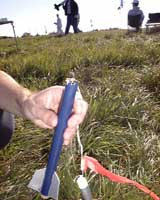
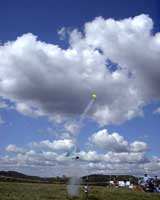
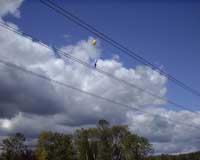
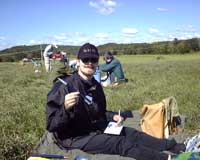
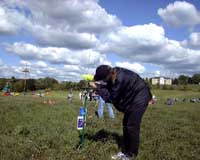
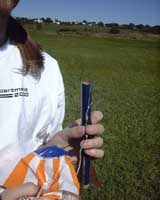
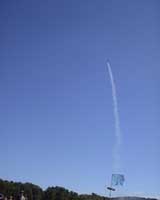
| ||||||||||||||||||||||||||||||||||||||||||||||||||||||||||||||||||||||||